Vietnam Overview
If you haven’t ever been to Vietnam before and are considering making it the next destination for your upcoming vacation, don’t hesitate to put this “First Time in Vietnam – Detailed Travel Guide” into your pocket..
Though Vietnam is a small, relatively unvisited country, whatever you are into, Vietnam likely has it all. There is a lot to love when it comes to traveling in Vietnam, ranging from soaring mountains and fascinating ethnic groups in the north, white sandy beaches and historic towns with UNESCO recognition in the central to vibrant waterways of Mekong delta and endless green rice paddies in the south. With over 3,000 km of coastline, nowadays the country is better known for its stunning beaches, towering limestone karsts, and high-octane cities.
Like any country, Vietnam also has its challenges when some travelers come home with tales of hectic roads, scams or pushy vendors. However, the country still has a lot of offer, either in natural beauties or culture, making it an overwhelming place for first-time travelers. Welcome to Vietnam!
Things to Know Before Visiting Vietnam
1. Sort out your visa
Speaking of traveling to any country, the visa is generally mentioned first. It is rather astonishing that many people who are going to visit Vietnam have no idea what to do for their Vietnam visa. In fact, residents of some specific countries are exempted for a visa to Vietnam for a certain period of time while others may be required to get a visa to enter Vietnam.
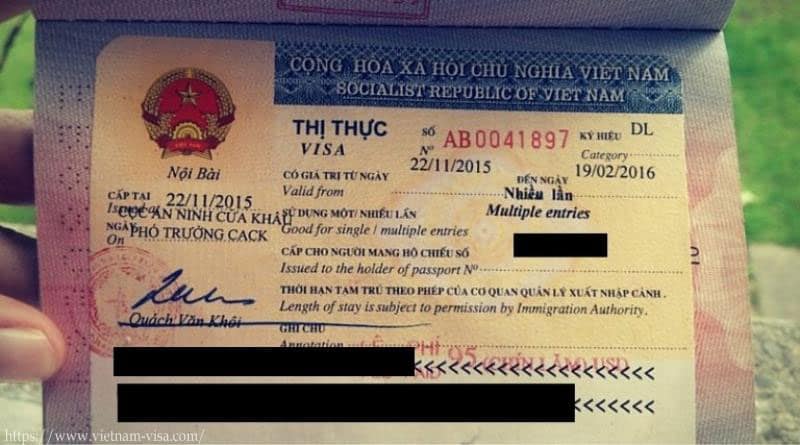
Vietnam visa
In the past, the process of getting a Vietnam visa at Vietnamese embassies is daunting and confusing, but fortunately, now travelers can consider applying for a visa on arrival (VOA) or e-visa which is so convenient and less time-consuming. Of course, visa on arrival has lots of advantages over other ways to obtain a Vietnam visa, but please notice that it is just applicable for air travel only. There are many companies that can do it for you online with a small fee.
Note: The visa situation for Vietnam differs for each nationality and changes regularly, so you should always check your nationality’s visa conditions prior to departure.
2. Weather varies so much
Vietnam is generally hot and humid. Since the country is long and thin in shape, its natural weather changes significantly depending on geography. There are 3 different weather regions in the country. At a time, it could be snowing in Sapa but blazingly hot in Phu Quoc.
Details about the weather in Vietnam:
- Northern Vietnam: expect hot wet summers and cool dry winters. From September to November, it can be cold here, especially adjacent to the border with China.
- Central Vietnam: expect dry, hot weather from January to August with approximately mid-thirty temperatures.
- Southern Vietnam: expect an entire tropical climate with only 2 seasons – dry and wet.
Due to varied weather conditions throughout the country, the best time to travel in Vietnam so as to fully enjoy your trip is from December to April.
3. People are friendly
Vietnamese culture is so special partly because Vietnamese people are very friendly, lovely, kind and giving. Some visitors said that, during their travels in Asia, they met and communicated with many friendly people from different places, but Vietnamese take it to a whole new level of kindness. Though people here might not have much, they still willingly share what they have with you.

Vietnamese people are friendly
4. Things are affordable
Vietnam is among the cheapest countries in Asia, so you can expect to have a cheap trip for your first time in Vietnam. Transport, hotels, drinks, meals, souvenirs, etc. are incredibly cheap compared with other Asian countries, namely Thailand. As just a bit of cash can go a long way, it means more travelers can afford to visit Vietnam.
5. Dress appropriately
Vietnam is not a conservative country regarding clothing and you do not need to dress like an Afghan woman. It is totally fine to wear a shirt, shorts, and flip-flops when visiting usual entertaining areas or walking on the streets, but it is advisable to wear something cover-up when visiting religious sites like temples.
If you are not sure about what to wear, simply do as locals do. Don’t forget to bring warm clothes if you are visiting the North during the winter months.
6. It is a food paradise
Recently, Vietnam begins to make headway in the circle of food in the world. Vietnamese food is unique with a perfect blend of sweet, sour, salty and savory flavors and tastes.
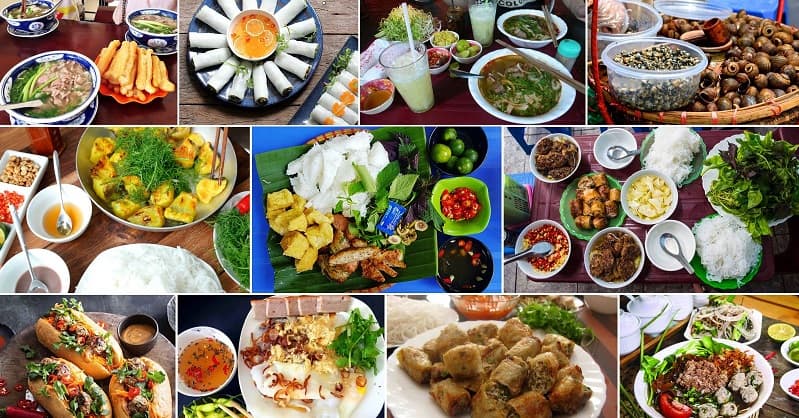
Vietnam is really a food paradise
Words are not enough for describing Vietnamese cuisine because it offers a valuable insight into the culture of the country. Being the heart of Vietnamese culture, Vietnam food varies by regions from the north to the south. Food tends to be less spicy in northern Vietnam, spicier in central Vietnam, and sweeter in southern Vietnam.
Famous dishes that tourists should not miss upon visiting Vietnam include fresh and fried spring rolls (Nem), rice noodles (Phở), steamed rice pancakes (Bánh Cuốn), Cha Ca, etc.
7. Public transportation is easy enough
Speaking of transportation in Vietnam, it can be said that Vietnam is one of the easiest countries in Asia thanks to its affordable, expansive and reliable network of means. As a traveler, you can get from any corner of Vietnam to any other using public transport.
There are many options travelers can choose from to travel around Vietnam. Not to mention trains and buses that suit long journeys, travelers visiting Vietnam have a wide range of means to move around during their trip. In big cities like Ho Chi Minh City or Hanoi, motorbikes (scooters) are literally everywhere so if you are a relatively adventurous traveler, you can rent one to get around. Other less-adventurous but still interesting options are cyclos (three-wheel bicycle taxis) and motorcycle taxis.
No matter what you do or where you go, make sure that you spend some time rolling on the river by boat to not miss any special travel experience in Vietnam.
8. Be aware of road safety
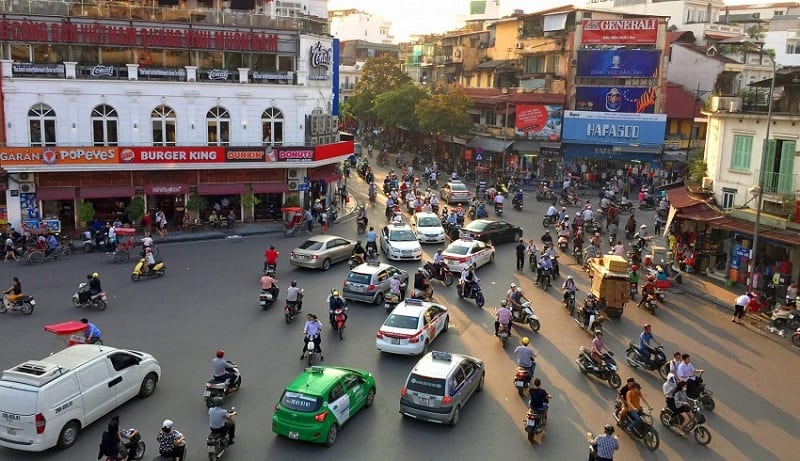
Vietnam traffic feature
Traffic in Hanoi and Ho Chi Minh City could be terrifying at first glance and walking across crowded streets during rush hour is like an impossible task in the eye of foreigners. However, it is not as hard as it appears. Just like a school of fish, the traffic will glide around you as long as you move at a steady and slow pace.
How Long To Stay In Vietnam for the First Time
The length of your first-time journey in Vietnam depends on how many days you want to travel. Some common options of traveling duration offered by travel agents are:
- Traveling Vietnam in a classic way (10 days),
- Traveling Vietnam combined with beach relax (14-15 days),
- Traveling northern Vietnam only (6 days), and
- Traveling southern Vietnam only (6 days)
First Time in Vietnam – Where to Go
1. Sapa
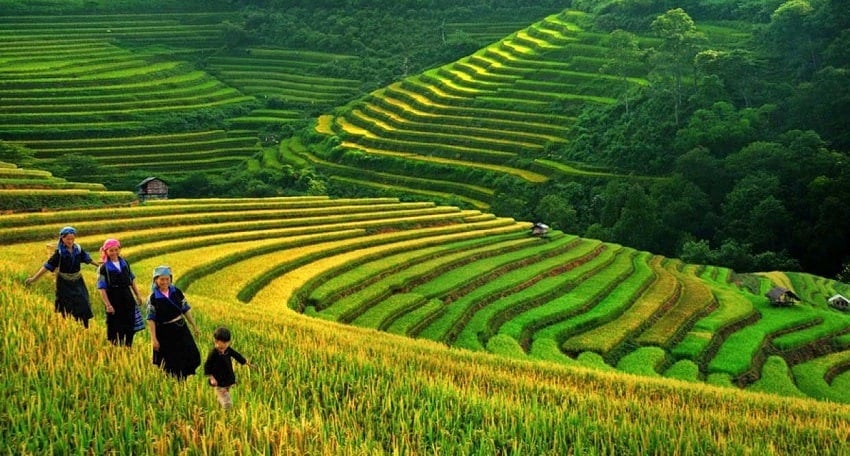
Sapa – beautiful, mountainous town in northern Vietnam
Sapa is probably the most popular tourist destination in the mountainous north-easterly region of Vietnam. It is a perfect highland escape from bustling cities thanks to breathtaking views of forests, terraced rice fields, and hidden natural wonders that will surely attract any adventurous travelers.
While its scenery is stunning, Sapa is also renowned for its intoxicating cultural makeup. Tiny villages dotted on the hills are home to many ethnic minorities and some of whom have inhabited in this land for thousands of years and are last remaining ones in Vietnam. Also home to countless species of animals, birds, and plants, Sapa is like a paradise of nature lovers.
2. Halong Bay
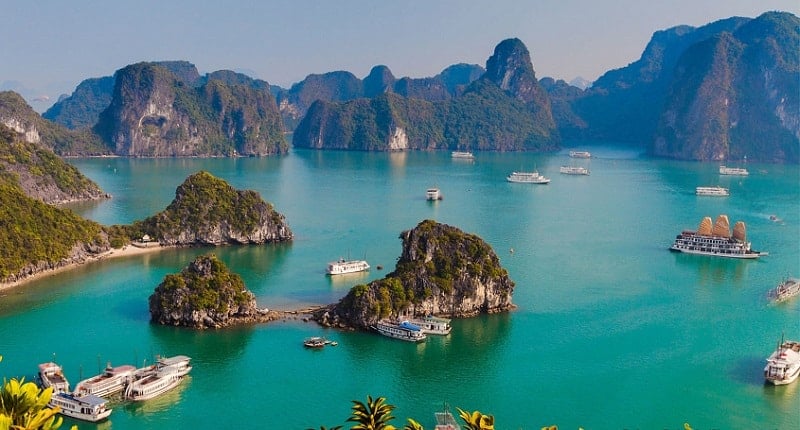
Halong Bay – a beautiful natural wonder in northern Vietnam
As a UNESCO World Heritage Site and potentially the most iconic region of Vietnam, Halong Bay has so much to offer. There are about 2,000 islands and islets made from karst limestone towering like skyscrapers throughout the bay. Besides, Halong Bay has a large system of 58 caves and each one has its own beauty and stories attached to it.
The best way to explore Halong Bay is taking a cruise/boat trip, on which you can look out over beautiful islands and floating houses of local fishermen on the bay.
3. Hanoi
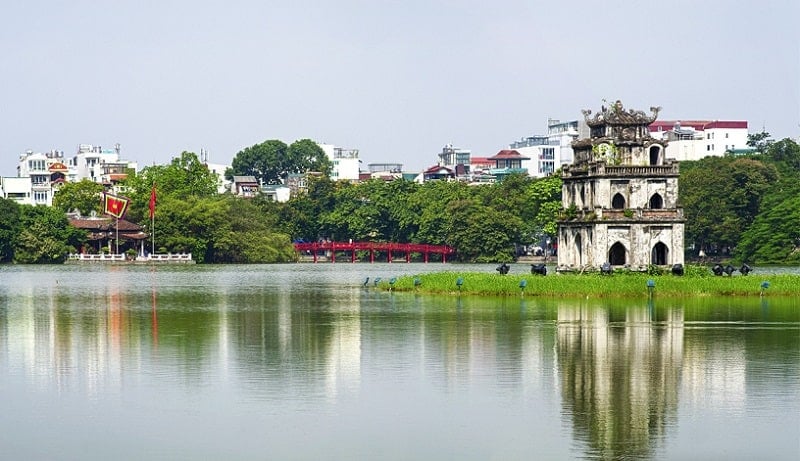
Hanoi – the capital city of Vietnam
Hanoi, one of the most ancient cities in the world, is the capital of Vietnam. As busy and chaotic as Hanoi could be, it is a fun place for tourists to explore on foot. Hanoi is riddled with history, from the ancient 1000-year-old to French Colonial architecture and Soviet-inspired culture buildings. This is a city of unique museums, peaceful pagodas and temples, tree-lined boulevards and alleyways, and sizzling cuisines.
Hanoians are very good at making and tasting the food, so it could be said that this is considered the most attractive thing for foreigners to visit and experience a “special Hanoi through specialties”.
4. Hue

Hue – the ancient city of Vietnam
Hue is located at Vietnam’s geographical heart and also one of the most photogenic cities in the country. If you are a history buff or love exploring exotic cultures, this former Royal Capital of Vietnam is surely on top of your travel plan. This ancient city had been given with a crown of World Heritage Site by UNESCO and has seen huge rejuvenation in recent years probably because of the government’s efforts to restore imperial citadel and booming tourism industry with a special concentration of nightlife.
Old gems lurking both on the streets and in the rural area; a complex of ancient monuments, tombs, and pagodas; amazing cuisine; and provincial warmth local people are characters contributing to Hue’s attraction.
A visit to Hue will not be completed without enjoying Hue cuisine which is famous for its bold flavors, intricacy, and debaucherous combinations of ingredients. In Hue, dinning not only satisfies human basic needs but also is a form of art. Some dishes not to miss in Hue are “Bun bo Hue”, “Com Hen”, “Banh bot loc”, and “Che”.
5. Hoi An
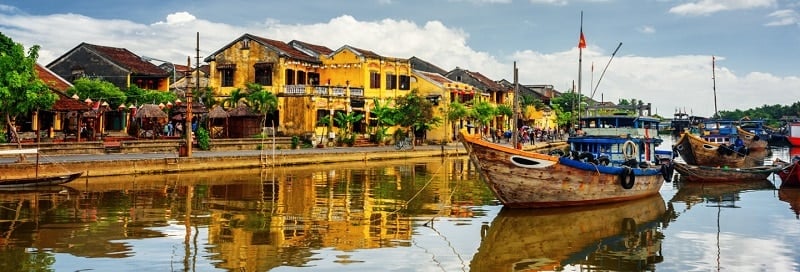
Hoi An – a well-preserved ancient town located in central Vietnam
Hoi An is renowned for its UNESCO World Heritage Old Town. Used to be the Southeast Asian trading port dating from the 15th-19th century, the town is packed with picturesque historical houses, street-side cafes, pagodas, and beaches. It is also popular for buying hand-made clothing and you can find anything made here, from custom-made suits to sundresses to gowns to leather boots. Lounge bars, travel agents boutique hotels, and a glut of tailor shops are part of the scene here.
Strolling through the atmospheric old streets, cycling in the countryside, tasting delicious local dishes, taking a cooking class, and relaxing at An Bang beach are unique experiences that tourists should not skip in Hoi An.
6. Ho Chi Minh City
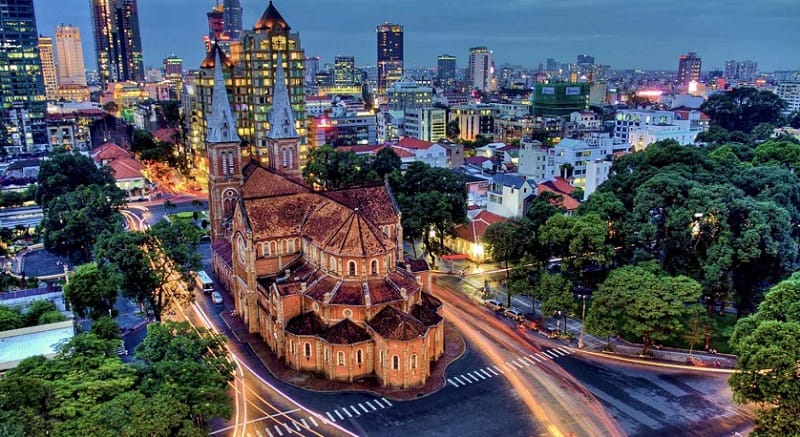
Ho Chi Minh city – the second heart and soul of Vietnam
This high-octane city is the commerce and culture hub of Vietnam. Also known as Saigon, Ho Chi Minh City along with its pulsating energy breathes vitality and life into local residents and tourists cannot help but be swirled following the ride. Not only is it Vietnam’s largest city, but it also boasts some of the most fascinating cultural relics. Not to mention the history, food stalls and crafts appear at every street corner of the city.
Saigon has a lot of offer, from classic French-style buildings, Buddhist-style temples, buzzy new hotels and restaurants to tasty street stalls, wonderful shops, and fantastic nightlife. Much of fun of being in Saigon derives from the plain pleasure of absorbing its activity’s flurry. For a foreign tourist with the first time in Vietnam, traveling Ho Chi Minh City is still the best choice to just enjoy and discover the country’s diversity and vastness.
7. Mui Ne
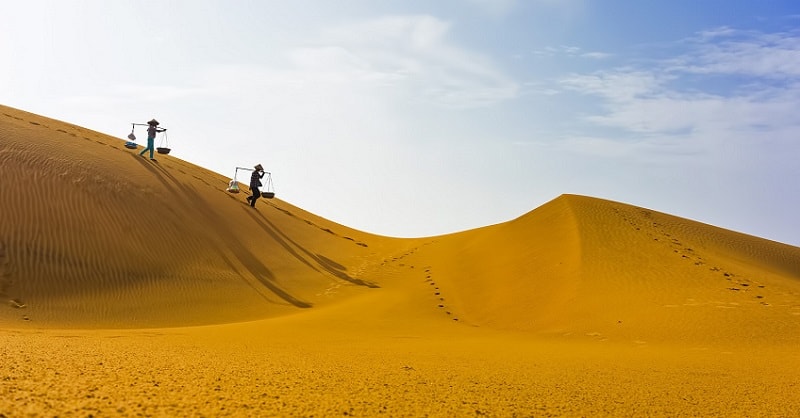
Mui Ne Sand Dunes – Great destination in Vietnam
Situated modestly just a few hours from the hustle and bustle of Ho Chi Minh City, Mui Ne is, without a doubt, the angel on the shoulder of Saigon favored by domestic and international travelers. This town is famous for an abundance of classy and comfortable resorts and hotels overlooking its fantastic coastline, sand dunes, white sandy beach, and temperate climate.
Mui Ne offers a perfect chance to just relax for several days and take a load off. The great thing about Mui Ne is that tourists can afford some great accommodation at incredibly low cost. In addition to playing watersports, tourists are highly recommended paying a visit to white and red sand dunes located about 25 km from Mui Ne center. Mui Ne Sea is considered the premier destination in Southeast Asia for kite surfing and other watersports like sailing, kite surfing, and windsurfing.
How to Get Around Vietnam
Getting around Vietnam is really easy for first-time visitors in Vietnam due to a wide range of transport options that travelers can choose from to travel in Vietnam, such as bus, train, coach, plane, ship and even boats. Though it is still a little rough around the edges, the transport network of Vietnam keeps improving. Its public transport system is amongst the cheapest in Southeast Asia. Here are 3 common ways for first-time travelers to travel around Vietnam:
1. Planes:
You may be surprised to know that Vietnam is home to over 20 international and domestic airports, connecting the country with the rest of the world. Nearly every city has its own airport. So far, many direct flights have been established for the convenience of traveling. For instance, as of late 2017, you could fly directly from London to Phu Quoc Island. Flights from a city to another are very cheap and no flight lasts than a couple of hours.
2. Buses:
Local buses are either a delight or a nightmare, depending on your own expectations. Perhaps, catching a bus is the most popular way to get around Vietnam. If you use buses during your first time in Vietnam then stick with the “open-tour-buses” operated by travel agents instead of National Bus Services. The latter one frequently stops at small towns along the route.
3. Trains:
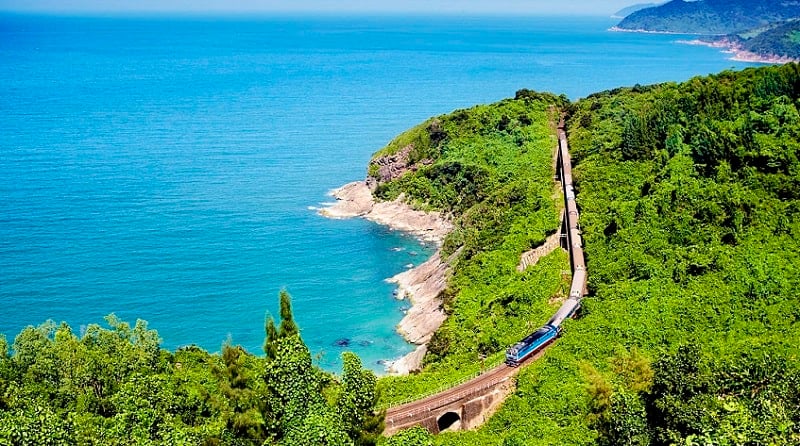
Travel in Vietnam by train
Taking a train along the coast of Vietnam is a great choice for those backpackers who want to explore Vietnam in a different way. The trains are delightfully retro, comfortable and offer a great way to sit back, relax and see staggering landscapes of Vietnam to pass you along the route. You will see the countryside rather than the blue sky (upon flying) or petrol stations and random shops (upon driving). With a number of classes on Vietnam trains, tourists are recommended springing for the highest level (the best) you could afford.
Other transport options to get around Vietnam include taxis, car, cyclo, motorcycle, motorbike or scooter, and boat.
First Time in Vietnam – What To Do
To be honest, Vietnam is not the easiest destination to visit for the first time. As a Southeast Asia’s travel gem, this S-shaped country is ideal for those who want to engage in meaningful cultural experiences. There are countless exotic destinations in Vietnam, from lush jungles, sandy beaches, and beautiful mountains to natural landscapes, colonial structures, and bustling cities. Exploring Vietnam is never a boring experience for first-time travelers.
Here are 5 things to do in Vietnam, bringing unique experiences that you won’t find anywhere else in the world!
1. Prehistoric landscapes of Halong Bay:
The beauty of Halong bay’s landscapes appeared in old paintings of Vietnam, with jagged, forested and limestone mountains jutting out of a spectacular bay. Unsurprisingly, this UNESCO World Heritage Site is one of the most popular tourist destinations in Vietnam. Visitors can opt for cruise tours of either one or two-day duration that include sleeping on board within the bay to contemplate its beauty with islands and islets on calm water.
2. World’s largest cave in Phong Nha
Phong Nha National park is home to the largest natural cave in the world. It is situated in central Vietnam and easily accessible by both bus and train from Hue. The cave is a complex of potentially hundreds of undiscovered grottoes and caves which bring mystery to the fascinating, gorgeous park.
3. Contemplate the “God’s hands” walking bridge in Da Nang
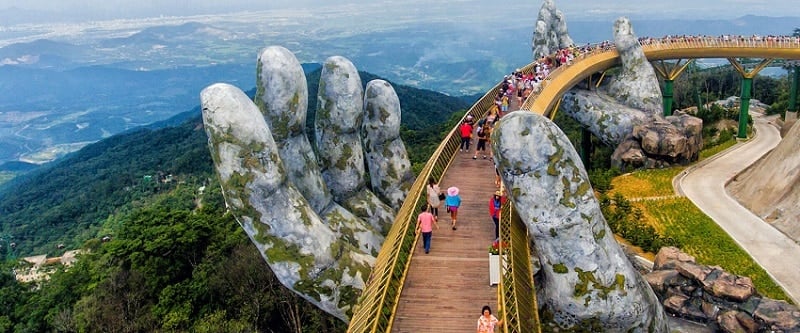
Golden Bridge – an emerging attraction in Da Nang
Built over 1000 meters from the ground, the enormous Golden Bridge is nestled between the central mountains of Vietnam. It is held by two giant stone hands on two sides of the bridge, explaining why it is associated with the title – God’s Hands. Golden Bridge pulls a strip of gold from mountains, creating such a walkway in the sky among the fairy-like and foggy woodlands of Ba Na Mountain.
4. Shop at the floating market in Mekong Delta
Also known as “Vietnam’s rice bowl”, Mekong Delta is the biggest delta of the country with a complex of river system called Cuu Long (Nine Dragons), interesting floating markets, Khmer villages and pagodas surrounded by green rice paddies. It stretches over 4,350 km and through its long journey, it has gathered a lot of nutrients and minerals serving to produce the incredibly fertile climate of Mekong Delta.
The floating markets are amongst tourist magnets of Mekong Delta, in which people could buy vegetables and fruits from locals. Here you will find vegetables, fruits, plants, fauna and flowers which cannot be found anywhere else on the earth.
5. Windsurfing paradise in Mui Ne
Mui Ne is rapidly becoming a Southeast Asian Mecca for windsurfing and kite-boarding thanks to its excellent conditions for water sports. Owing to the strongest and most consistent cross-onshore winds in Asia as well as the lowest rainfall in Vietnam, every day in Mui Ne is a perfect day. For watersport lovers or windsurfers, adding Mui Ne to their bucket list is a must.
Eating in Vietnam for The First Time
Regarding Vietnamese food, it is endlessly diverse and fabulously complex. There are wonderful things waiting for you ahead and surely making your journey an enjoyable adventure of food from the North to the South. Due to differences in resources and climate, popular dishes in the north might not even exist in the south and vice versa. Whether or not you are a foodie, Vietnam will offer you the foods out of this world.
In the north, spices and herbs are not used as frequently as in the cookery of southern Vietnam due to the cooler climate. Most northern Vietnamese cuisines are often flavorful and vibrant, resulting from subtle combinations of different flavoring ingredients. Central cuisine is notable for its bold and boasts the most complex and flavorful cuisine in Vietnam.
First-time travelers should not miss going for street food in Vietnam. Being afraid to try street food will make you miss out on a huge part of Vietnamese culture. Eating on streets is really as authentic experience in Vietnam and a fantastic way to travel on a budget with just about $1-2 for full indulging meals.
To be honest, eating in Vietnam has its own challenges and the main one is narrowing down numerous food options available throughout the country. Some must-try Vietnamese foods are Pho, Banh Mi, Bun Cha, Goi Cuon, Bun Bo Hue, Banh Cuon, etc.



